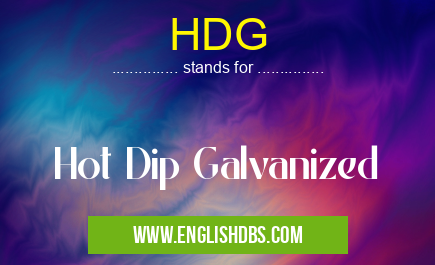What does HDG mean in UNCLASSIFIED
Hot Dip Galvanizing (HDG) is a process of applying a protective zinc coating to iron or steel surfaces to prevent corrosion. The process involves immersing the metal in a molten zinc bath, which adheres to the surface and forms a metallurgical bond.

HDG meaning in Unclassified in Miscellaneous
HDG mostly used in an acronym Unclassified in Category Miscellaneous that means Hot Dip Galvanized
Shorthand: HDG,
Full Form: Hot Dip Galvanized
For more information of "Hot Dip Galvanized", see the section below.
What is HDG?
HDG is a popular method of corrosion protection for various applications, including:
- Structural steel
- Pipes and fittings
- Automotive components
- Fencing
- Roofing
Benefits of HDG
- Corrosion resistance: The zinc coating acts as a sacrificial anode, protecting the underlying metal from rust and corrosion.
- Durability: HDG coatings can last for decades, depending on the environment and thickness of the coating.
- Low maintenance: HDG coatings require minimal maintenance, making them a cost-effective solution.
- Aesthetic appeal: HDG coatings provide a uniform, metallic finish that can enhance the appearance of metal structures.
Process of HDG
The HDG process typically involves the following steps:
- Surface preparation: The metal is cleaned to remove any dirt, grease, or impurities.
- Fluxing: A flux is applied to promote bonding between the zinc and the metal.
- Galvanizing: The metal is immersed in a molten zinc bath at a temperature of around 450°C (842°F).
- Cooling: The metal is cooled rapidly to create a smooth, crystalline zinc coating.
Essential Questions and Answers on Hot Dip Galvanized in "MISCELLANEOUS»UNFILED"
What is Hot Dip Galvanizing (HDG)?
Hot Dip Galvanizing (HDG) is a process in which steel is immersed in a molten zinc bath to create a protective layer of zinc on the surface. This coating protects the steel from corrosion caused by exposure to moisture, oxygen, and other environmental factors.
Why is HDG important?
HDG is important because it provides long-lasting protection against corrosion, extending the service life of steel structures. It is particularly effective in harsh environments, such as coastal areas, industrial settings, and regions with high humidity.
How does HDG work?
When steel is immersed in the molten zinc bath, a metallurgical reaction occurs. The zinc atoms react with the iron on the steel's surface to form an alloy layer, which is then covered by a layer of pure zinc. This zinc coating acts as a barrier, preventing corrosive elements from reaching the steel substrate.
What are the benefits of HDG?
HDG offers several benefits, including:
- Long-lasting corrosion protection
- Cost-effectiveness over the long term
- Minimal maintenance requirements
- Enhanced durability and strength
- Improved aesthetics
What are the applications of HDG?
HDG is used in a wide range of applications, such as:
- Structural steel
- Automotive components
- Storage tanks
- Pipes and fittings
- Marine structures
- Outdoor furniture
Final Words: HDG is a highly effective and widely used method of corrosion protection for metal surfaces. Its advantages include durability, low maintenance, and aesthetic appeal. Understanding the process and benefits of HDG can help industries and individuals make informed decisions about corrosion prevention strategies.
